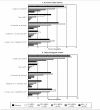Potential implications of missing income data in population-based surveys: an example from a postpartum survey in California
- PMID: 18051668
- PMCID: PMC1997243
- DOI: 10.1177/003335490712200607
Potential implications of missing income data in population-based surveys: an example from a postpartum survey in California
Abstract
Objectives: Income data are often missing for substantial proportions of survey participants and these records are often dropped from analyses. To explore the implications of excluding records with missing income, we examined characteristics of survey participants with and without income information.
Methods: Using statewide population-based postpartum survey data from the California Maternal and Infant Health Assessment, we compared the age, education, parity, marital status, timely prenatal care initiation, and neighborhood poverty characteristics of women with and without reported income data, overall, and by race/ethnicity/nativity.
Results: Overall, compared with respondents who reported income, respondents with missing income information generally appeared younger, less educated, and of lower parity. They were more likely to be unmarried, to have received delayed or no prenatal care, and to reside in poor neighborhoods; and they generally appeared more similar to lower- than higher-income women. However, the patterns appeared to vary by racial/ethnic/nativity group. For example, among U.S.-born African American women, the characteristics of the missing-income group were generally similar to those of low-income women, while European American women with missing income information more closely resembled their moderate-income counterparts.
Conclusions: Respondents with missing income information may not be a random subset of population-based survey participants and may differ on other relevant sociodemographic characteristics. Before deciding how to deal analytically with missing income information, researchers should examine relevant characteristics and consider how different approaches could affect study findings. Particularly for ethnically diverse populations, we recommend including a missing income category or employing multiple-imputation techniques rather than excluding those records.
Figures


Comment in
-
Implications of missing income data.Public Health Rep. 2008 May-Jun;123(3):260; author reply 260-1. doi: 10.1177/003335490812300303. Public Health Rep. 2008. PMID: 19006964 Free PMC article. No abstract available.
Similar articles
-
Socioeconomic and racial/ethnic disparities in unintended pregnancy among postpartum women in California.Matern Child Health J. 2002 Dec;6(4):237-46. doi: 10.1023/a:1021158016268. Matern Child Health J. 2002. PMID: 12512765
-
Post-partum Residential Mobility Among a Statewide Representative Sample of California Women, 2003-2007.Matern Child Health J. 2016 Jan;20(1):139-148. doi: 10.1007/s10995-015-1812-0. Matern Child Health J. 2016. PMID: 26210781
-
The prevalence of low income among childbearing women in California: implications for the private and public sectors.Am J Public Health. 1999 Jun;89(6):868-74. doi: 10.2105/ajph.89.6.868. Am J Public Health. 1999. PMID: 10358677 Free PMC article.
-
Measuring socioeconomic status/position in studies of racial/ethnic disparities: maternal and infant health.Public Health Rep. 2001 Sep-Oct;116(5):449-63. doi: 10.1093/phr/116.5.449. Public Health Rep. 2001. PMID: 12042609 Free PMC article.
-
Racial/Ethnic Disparities in Depressive Symptoms Among Pregnant Women Vary by Income and Neighborhood Poverty.AIMS Public Health. 2015 Jul 31;2(3):411-425. doi: 10.3934/publichealth.2015.3.411. eCollection 2015. AIMS Public Health. 2015. PMID: 29546117 Free PMC article.
Cited by
-
Widening health inequalities between the employed and the unemployed: A decomposition of trends in Canada (2000-2014).PLoS One. 2018 Nov 29;13(11):e0208444. doi: 10.1371/journal.pone.0208444. eCollection 2018. PLoS One. 2018. PMID: 30496288 Free PMC article.
-
Socioeconomic and demographic predictors of selected cardiovascular risk factors among adults living in Pohnpei, Federated States of Micronesia.BMC Public Health. 2014 Aug 31;14:895. doi: 10.1186/1471-2458-14-895. BMC Public Health. 2014. PMID: 25175388 Free PMC article.
-
Relationship of Age for Grade and Pubertal Stage to Early Initiation of Substance Use.Prev Chronic Dis. 2015 Nov 19;12:E203. doi: 10.5888/pcd12.150234. Prev Chronic Dis. 2015. PMID: 26583575 Free PMC article.
-
Longitudinal transitions in e-cigarette and cigarette use among US adults: prospective cohort study.Lancet Reg Health Am. 2023 May 16;22:100508. doi: 10.1016/j.lana.2023.100508. eCollection 2023 Jun. Lancet Reg Health Am. 2023. PMID: 37229421 Free PMC article.
-
The Association Between Adverse Childhood Experiences and Preterm Delivery: A Latent Class Approach.J Womens Health (Larchmt). 2024 Apr;33(4):522-531. doi: 10.1089/jwh.2023.0196. Epub 2024 Mar 8. J Womens Health (Larchmt). 2024. PMID: 38457646 Free PMC article.
References
-
- Lantz PM, House JS, Lepkowski JM, Williams DR, Mero RP, Chen J. Socioeconomic factors, health behaviors, and mortality: results from a nationally representative prospective study of US adults. JAMA. 1998;279:1703–8. - PubMed
-
- Rao SV, Schulman KA, Curtis LH, Gersh BJ, Jollis JG. Socioeconomic status and outcome following acute myocardial infarction in elderly patients. Arch Intern Med. 2004;164:1128–33. - PubMed
-
- Backlund E, Sorlie PD, Johnson NJ. The shape of the relationship between income and mortality in the United States. Evidence from the National Longitudinal Mortality Study. Ann Epidemiol. 1996;6:12–20. - PubMed
-
- Avendano M, Kunst AE, van Lenthe F, Box V, Valkonen T, Cardano M, et al. Trends in socioeconomic disparities in stroke mortality in six European countries between 1981–1985 and 1991–1995. Am J Epidemiol. 2005;161:52–61. - PubMed
Publication types
MeSH terms
LinkOut - more resources
Full Text Sources
Medical

